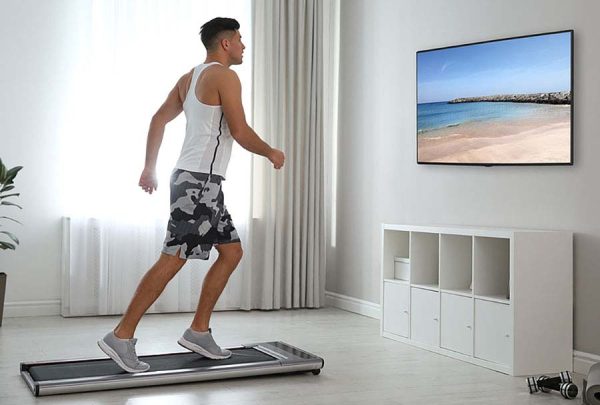What if your goal was fat loss and you did an hour a day of low-intensity cardio? Would that be a good idea compared to moderate intensity cardio with slightly shorter workouts, or high intensity cardio with much shorter workouts? What if you did an hour and a half, or even (gasp) two hours a day of low intensity cardio. What about that? Bad? Total overkill? Or could that actually be a secret to losing fat fast that most people never use because it’s too time consuming? What if you had the time? That’s exactly what a Burn the Fat reader asked recently. Read on to see his unusual question and my answer…

Q: Hi Tom. Your Burn the Fat, Feed the Muscle book says that for maximum fat loss, the standard guideline for cardio is up to 5-7 days per week and up to 40-60 minutes per session at a moderate intensity, or 20-30 minutes per session at a higher intensity. My question is, can I do low-intensity steady state (LISS) cardio for as long as I want even if it exceeds these guidelines? I am already doing resistance-training 3-4 days a week, but I’m looking for ways to increase my activity-levels to maximize the amount of calories I burn, especially since I have a sedentary 9 to 5 job.
When I refer to LISS cardio, I mean walking outside when the weather is good and riding my stationary bike indoors when the weather is bad. I like to watch movies when I’m riding. Sometimes the movies are 90 minutes to 2 hours long and I was wondering if it’s okay to ride that long. I assume it’s okay because the intensity is low. I’m fortunate in that I have loads of spare-time so I’d like to do the maximum amount I can to burn the most fat possible, but I realize that any extra exercise I do, besides my lifting, should be mostly lower intensity to avoid overuse injuries. I’d be very interested to hear your thoughts on whether or not it is safe to do such a large amount of LISS cardio each day when time permits.
A: This is an interesting question because most people ask about how to spend less time doing cardio not more.
Here’s my short answer:
Yes, it’s okay ride your bike for an hour and a half or even two hours while you watch a movie or take equally long walks, especially when it’s done with low intensity, which is not stressful to the body. (I take two hour walks myself – not every day, but quite often). It’s simply not realistic for most people given time limitations. If you have the time (and if it seems like a good use of your recreational time), if you like doing it, if it’s producing results, if it’s not compromising your lifting, and if you’re seeing no adverse effects (overtraining symptoms or overuse injuries), then it might be a smart strategy for you. It would almost certainly give you a fat loss advantage over those who don’t have the time, as long as you keep controlling your diet.
Whether long duration, low intensity cardio is an essential strategy for fat loss or necessary for health benefits are separate questions. To address them, here is the long answer below, where I will take a deep dive into this subject and leave no stone unturned.
Why High Volume Cardio Is Not Essential For Fat Loss Or Health But Proper Diet Is
Doing more than 40 to 60 minutes of cardio every day is not essential for reaching fat loss goals. Fat loss is achieved by staying in a calorie deficit and you accomplish that most efficiently through dietary control.
If you don’t control your eating while adding in large amounts of cardio, it’s possible to see no fat loss from all that activity because you’re cancelling out the exercise deficit with more eating. If you do that, you’re on a hamster wheel going no where and nothing could feel more frustrating than doing hours of cardio with no fat loss.
Be sure to read my piece, “You Can’t Out Train A Bad Diet” if you want to learn more.
It’s possible to reach most fat loss goals with no cardio at all, only caloric restriction (with weight training to support muscle retention). The cardio simply accelerates the fat loss because it allows you to achieve a larger deficit, so cardio is recommended for fat loss programs. Cardio is also important for optimizing health.
For Health And Fat Loss, How Much Exercise Is Enough? How Much Is Too Much?
For health, it doesn’t take that much exercise when you consider that even walking counts as meaningful physical activity (low to moderate intensity cardio). You can quantify how much by minutes per day or week. Counting steps per day has also become well accepted as a method for tracking activity. 8,000 to 10,000 steps a day provides most of the potential health benefits, but it would probably take quite a bit more to create a big increase in fat loss.
Nearly all the major health and fitness organizations suggest a minimum of 150 minutes of moderate exercise (defined as at least the intensity of brisk walking) per week. That’s 30 minutes 5 days a week. Even better is 210 minutes per week, which is 40 to 45 minutes 5 days a week or 30 minutes 7 days a week. Also, this walking can be broken up into two or three shorter sessions each day and you can get the same health benefits.
These recommendations of 30 to 45 minutes of moderate intensity cardio five days a week for good health are going to help with fat loss as well. But if the intensity is too low, as in casual walking, then it’s not as time efficient.
For the average busy person, it’s more efficient to bump the intensity of steady state cardio a little so the heart rate is higher. Alternately, you can bump up the intensity a lot and do shorter sessions of interval training two or three times a week without worries about overtraining.
Or, you can simply fine tune your dietary control and increase diet adherence. It’s important to understand that to increase fat loss, you can work on both sides of the energy balance equation. In many cases, the decision is influenced on your time available.
The Importance Of Considering Your Time Available And Training Efficiency
Again, the main issue for most people is lack of time. This has always been cited as the number one barrier that most people face in trying to exercise consistently. Time efficiency tactics for both cardio and resistance exercise are a must or adherence will be a problem for many people.
This is especially true because humans tend to be all or nothing thinkers. If you’re a coach and you tell a busy client that it’s mandatory to do 40 to 60 minutes of cardio most days of the week, on top of lifting several times a week, plus meal prepping, many will end up doing nothing and drop out. The idea of doing more than 60 minutes a day, let alone 90 or 120 minutes simply isn’t on the table for these people.
Time efficient exercise programs are critical for most people. That’s why it’s no surprise that high intensity interval workouts are still so widely recommended and resistance workouts like our TNB TURBO are our most popular.
TNB TURBO: Ultra Time Efficient Resistance Training For More Muscle In Less Time
It’s not uncommon for endurance athletes to do two hour rides or runs. The difference is, they are training for fitness and performance in a sport not necessarily for fat loss and health per se.
Typically they do one long run or ride on the weekend, with shorter sessions during the workweek, so they’re not long sessions every day. They usually also do at least one shorter but more intense workout during the week. It’s not easy, but even busy people with 9 to 5 jobs train for events like marathons because there’s only one long time-consuming run per week.
For competitive endurance athletes, the long session is a vital part of their training strategy to condition their bodies. For people seeking fat loss and health goals, ultra long cardio sessions are never mandatory, always optional and only when it makes sense.
Here’s another point to consider. Most athletes who train long hours are usually fueling themselves for top performance and weight maintenance, not doing hours of cardio in a calorie deficit for weight loss. Potential negative effects of high exercise volume are exacerbated when you are calorie restricted.
The Importance Of Choosing Exercise You Like
With all this in mind, we can see that spending as much as two hours a day doing low intensity exercise is not a sensible option for most people. At the very least, there are pros and cons. For a handful of people without time restrictions however, it can make sense, especially if the activity is enjoyable and not too energy-sapping. Lots of people love long walks and hikes outdoors for example, but loathe jogging on a treadmill.
You can choose any style of cardio you like, whether that’s longer low intensity cardio or shorter, high-intensity cardio, whether it’s indoors or outdoors, using machines or your own body. Some people do not like doing intense cardio or it’s risky for them due to orthopedic issues. Some people don’t like to be indoors if the weather is nice outside.
Choosing a style of exercise you enjoy is a smart move. It’s proven (in research and in practice) to increase your chances of sticking with your program until you reach your goal (adherence), and increase your chances of staying in shape long term (maintenance). If you have the time and you like low intensity cycling in front of the TV or slow walking outdoors, long sessions can make sense if it’s working for you.
The Wisdom Of Balancing Efficiency With Effectiveness
Even with exercise of your choice at a low intensity, I rarely recommend more than 40 to 60 minutes of cardio a day when the intention is purely fat loss. If I did, it would probably be for only a short time to reach peak condition as fast as possible and then I would cycle back to a more sustainable volume (you don’t need as much cardio for maintenance anyway).
As people who have followed me for years know, there were occasions during my competitive bodybuilding career when I did as much as two sessions of cardio per day totaling 80 to 90 minutes. Was it effective for fat loss? Very. But in hindsight, I’m concerned that doing this can increase the risk of muscle loss while in a deficit unless the intensity is very low. If it were casual walking or slow pedaling on a bike, I’d be less worried, but then that’s time consuming and less efficient.
That’s why I usually stick with the duration, frequency and intensity guidelines I wrote about in my Burn the Fat, Feed the Muscle book, which were quoted above. Many people start with even less cardio than that – often only 3 or 4 days a week for 30 minutes at first. Unless there’s a deadline, they keep the additional cardio as an “Ace in the hole” and build up gradually if they need it to speed up results or break a plateau.
I understand that some people want to jump right in and do the maximum amount safely possible from day one so they can get the maximum results in the least amount of time. But it’s worth emphasizing that if you can’t get the fat loss results you want with 45 minutes or an hour per day of cardio, on top of weight training, then lack of activity is not the problem. There is something very wrong with your nutrition. Everything you’re burning, you’re just eating back. In many cases, it’s better to work on tightening up your nutrition than to keep adding more and more cardio. This is certainly true for busy people.
Capping cardio at an hour (or less) a day could also decrease the risk of over-use injury, over-training, interference with strength or muscle gains and metabolic adaptation. Granted, when the intensity of cardio is low like slow cycling or casual walking, there’s not much risk of these side effects. Whether you want to spend 90 minutes or two hours a day doing it is more a question of efficiency.
The biggest disadvantage to doing hours of low intensity cardio like walking is that it’s not time efficient. With moderate to high intensity cardio, you could get the same fat loss in half that time or even less.
But What About Doing More Cardio When You Want Maximum Fat Loss As Fast As Possible?
Doing more cardio during a fat loss phase than during a muscle building or maintenance phase makes sense. Progressively increasing cardio as needed to reach a peak condition at a certain date is also a smart strategy. But when you simultaneously adhere to a strict diet and manipulate calories in, not just calories burned, you often discover that you don’t need to increase cardio as much you thought. You also find you have more energy for lifting and more time for work or recreational activities.
We sponsor a Burn The Fat walking challenge twice year. I got a fitbit step tracker and I’ve always unofficially participated in the challenges myself, so I’ve been able to see the effects of doing large amounts of low intensity cardio on my physique and level of body fat.
My normal step goal is 12,500 a day. During the last several challenges, I walked at least 14,000 steps a day and up to as much as 18,000 steps a day on average. Sometimes that included walks or hikes of two hours a day or more especially when I was out on the trails. Sometimes it was broken up into multiple shorter walks, and that step total also included all random activity like walking around the house or running errands like shopping. I was also weight training hard 4 to 5 days a week. Doing that amount of walking, which is low-intensity exercise, I experienced no overuse injury and no interference with my weight training, but I did notice the downside.
As mentioned above, I found high volumes of low intensity cardio was not a great time trade off given how busy I am and what other options are available for getting lean. I enjoyed the walking, but I didn’t feel like I got an extraordinary increase in fat loss for the additional time invested. I did it anyway because our fitness challenge is a fun event that only lasts a few months.
I also enjoy hiking outdoors in scenic places and I would do that for enjoyment alone with no regard to the effect on fat loss. Sometimes I’m out there all day long. But due to the time inefficiency, for dedicated fat loss training, slow walking (or pedaling) for two hours a day is not the type of cardio training I would make my first choice.
Instead I could use diet as the primary driver of fat loss. As the secondary driver of fat loss I use moderate to moderately-high intensity cardio. Even just 25 to 30 minutes of high intensity cardio or 40-45 minutes of steady moderate cardio most days of the week has always produced equal or better fat loss results for me than two hours of low intensity exercise like slow walking.
I’m not saying that long walks (or long slow rides on a bike) won’t help at all – they certainly will. And if you walk very briskly on an inclined treadmill (or up and down in the hills) the workout can be a lot more intense and burn more calories. I’m only saying that very low intensity exercise burns fewer calories and takes the fat off much more slowly and therefore requires more time to get the same job done.
Formal Cardio Vs. Non Exercise Activity
Casual walking doesn’t necessarily qualify as a formal cardio session. Very slow walking or the incidental steps you accumulate during the day during normal activities are better categorized as non exercise activity (NEAT). There are health benefits to almost all physical activity, but light long duration physical activity doesn’t get your heart rate and breathing up enough to improve cardio-respiratory fitness as much.
The fastest fat loss I’ve ever achieved without any significant negative effects, that I still consider efficient, was building up to a program of 6-7 days a week of formal cardio, alternating between short high intensity sessions (20 to 30 minutes of HIIT) and longer moderate intensity sessions (40-50 minutes steady).
The reason for this mixed-intensity approach is because high intensity cardio is more efficient, but doing intense cardio daily does increase the risk of over-use injuries. It also increases the risk of interference effects in your resistance training, especially compromising leg strength and muscle size.
For example, if you run sprint intervals, run hill repeats or sprint on a cycle, and you do it hard, that’s almost like another leg workout. If you also train legs once or twice a week using weights, we could say you’re doing 7 or 8 leg workouts a week. Even though this isn’t like squatting with high volume every day, it’s still taxing to your body. Rotating intense cardio with less intense cardio reduces the risk of interference effects and reduces the risk of overuse injury.
Bottom Line: Should You Do 90 Minutes Or Two Hours Of Cardio A Day?
Most people probably shouldn’t do an hour and a half to two hours of cardio a day, especially any kind of intense or high impact cardio. However, it might be okay for some people.
It’s hard to overdo low intensity cardio like walking or slow pedaling on a bike. You’re not likely to overtrain by doing 90 to 120 minutes of casual walking a day because it’s simply not that strenuous or taxing to the body.
So, as long as your diet and weight training remain priorities, adding in some long exercise sessions makes sense when it’s low in intensity. It makes even more sense if you don’t do it seven days a week, and you’re more like the weekend hiker spending half the day in the woods or the runner with a single long session once a week.
The only question remaining is this: if your intention is fat loss, do you want to spend two hours every day if you could get equal results in half or even a third of that time? Maybe you do. Maybe that’s how you want to spend your recreational free time.
Also, if you were going to watch those TV shows or movies anyway, I think it’s a great idea to put a bike or treadmill in front of the screen.
Replacing sedentary time with active time is a proven and powerful strategy for getting healthy and lean. Many people listen to podcasts or audiobooks on long walks. If you wanted to do that anyway, then you’re killing two birds with one stone. It’s the only kind of multi-tasking I believe in.
I often take 60, 90 or even 120 minute walks, and I have listened to thousands of hours of audiobooks and audio seminars over the years that way. I always considered that time well spent even when it was only light exercise. I love to walk and hike slowly in the quiet outdoors as well. I consider it enjoyable, and also time well spent even without listening to audios.
Even if someone does not enjoy exercise, if they do enjoy watching certain TV shows or listening to audio programs or books, they can use that to their advantage.
Temptation Bundling
In psychology there is a technique known as temptation bundling. It was researched by Katy Milkman from the Wharton School (University of Pennsylvania) and she wrote about it in her book, How To Change. It’s based on the human tendency to favor instant gratification and give in to temptations over long term rewards. In addition to making an activity fun or gamifying it (as in using fitness trackers or joining step challenges), temptation bundling is another solution to spending time more productively.
This technique is where you allow yourself to indulge in a guilty pleasure or enjoyable activity like binge watching Netflix only when doing a virtuous activity that you might normally dread or put off. This reduces indulgence in temptations like lounging on the couch eating while you watch, and increases time spent in activities that help you reach your long-term goals. Studies show that this is especially effective with exercise.
If you make a promise that you’ll allow yourself to binge watch Netflix or listen to hours of audiobooks and podcasts every week, but you will only do so when you’re exercising, you are using temptation bundling. Understanding that you can choose a type of exercise you don’t hate and also that it could be low or moderate (not high) intensity exercise, that’s an easy bargain to accept. And for what it’s worth, it can be quite comfortable pedaling on a recumbent bike even through a couple episodes of your favorite show.
Remember that to maintain activity, especially at high levels, it’s important to make your own choice of exercise and make it one you enjoy. Gamification also helps. Using fitness trackers helps countless people stay highly active by counting daily steps. Since FitBit no longer features challenges, a bunch of us at Burn the Fat Inner Circle have started using the Stridekick app, and of course continue participating in our Burn the Fat Step Challenges.
Conclusion
The bottom line is, if you like long duration, low intensity cardio, and you’re not seeing any negative effects, only benefits, then you can disregard traditional cardio guidelines or expert opinions.
And believe me, you’ll find plenty of “experts” in the strength and physique world who are weight lifting focused and have only derogatory things to say about doing a lot of cardio and endurance exercise. Pay closer attention to what your own body is telling you. Your own results and satisfaction with the process are what count.
We run our Burn the Fat 10,000 steps a day challenge twice a year. Once in the spring and once in the fall. If you want some motivation to increase your step count, so you can burn more fat and get healthier, click the link below to see when the next event starts:
Tom Venuto,
Author of Burn the Fat, Feed the Muscle – The Bible Of Fat Loss
Founder, Burn the Fat Inner Circle

Tom Venuto is a natural bodybuilding and fat loss expert. He is also a recipe creator specializing in fat-burning, muscle-building cooking. Tom is a former competitive bodybuilder and today works as a full-time fitness coach, writer, blogger, and author. In his spare time, he is an avid outdoor enthusiast and backpacker. His book, Burn The Fat, Feed The Muscle is an international bestseller, first as an ebook and now as a hardcover and audiobook. The Body Fat Solution, Tom’s book about emotional eating and long-term weight maintenance, was an Oprah Magazine and Men’s Fitness Magazine pick. Tom is also the founder of Burn The Fat Inner Circle – a fitness support community with over 55,000 members worldwide since 2006. Click here to learn more about Burn the fat Inner Circle






Okay, but if we like the slow walking, but use it exclusively in lieu of any more intense cardio, are we not sacrificing the benefits to our cardio-vascular system? Or is an intense weight workout enough when our heart rate has brief bursts of increase? I’ve always thought that to improve the cardio-vascular system you need to increase your heartrate at least moderately for benefits. Slow walks do t do that -at least not the slow, casual stop and go bird-watching leisurely paced ones. Thoughts?
Hi Cin. Here’s a good way to look at it. Think about cardio / aerobic exercise as having three primary benefits (there are more, like mental benefits, but these are the primary physical ones):
1. fat loss benefits (by way of increasing calorie burn and therefore calorie deficit, as long as you don’t eat more than before). 2. health benefits (in a variety of areas including cardiovascular health markers). 3. Cardiovascular fitness and conditioning (as in athletic performance, increased vo2 max, not huffing and puffing when you climb the stairs, etc).
This entire blog post was focused on the singular context of fat loss. What we know about the other two benefits is this: even moderate walking provides health benefits similar to cardio as intense as running. But the higher intensity cardio provides the same benefits in less time.
If Im reading y our question correctly, where you are correct is that low intensity cardio like walking does not provide the cardiovascular fitness benefits that moderate and higher intensity cardio does. In other words, walking can help with fat loss (but it takes longer), and walking can improve health (but again, it takes more time walking for equal benefits. But where walking falls short it is does not provide the same cardiovascular fitness benefits as higher intensity cardio.
This is why my best recommendation for cardio is to combine moderate to higher intensity cardio with lower intensity cardio like walking throughout the week. If you were going to do some kind of cardio/aerobic exercise every day, it might look like this: 4-5 days of low intensity, 2-3 days of higher intensity. Or if you were going to do cardio/aerob ic exercise 6 days a week it might look like this: 4 days of low intensity, 2 days of higher intensity.
The reason there is more lower than higher intensity cardio recommended here is because if you over-do the high intensity stuff, and especially sprint intervals, and you are also lifting, you are more likely to overtrain, and that will manifest the most by way of a reduction in lower body strength and muscle gain.
Does this make sense? Remember, context is everything. are we talking about fat loss, health, or fitness? This post was responding to a question about fat loss. Cheers!
PS. Yesterday for the high intensity stuff, I was doing hill repeats – running up and down hills. But I only do that once a week. And one other day a week I run with strides (intervals). The rest of the week I walk, and I might do one easy run. I think mixing it up is ideal for the most benefits in all three areas.
Correction: slow (leisurely) walks do NOT do that (increase heart rate to a moderately aerobic level to improve cardiovascular system)